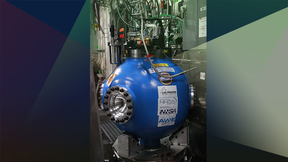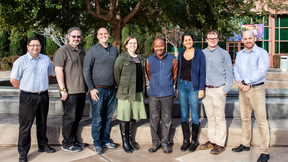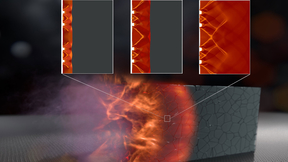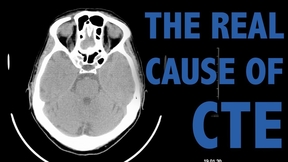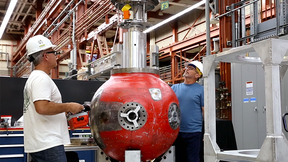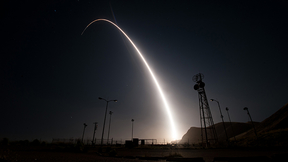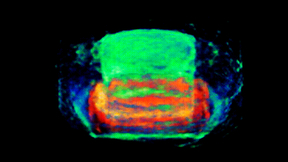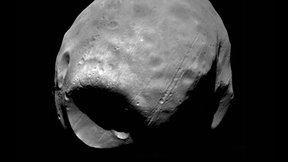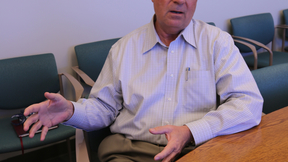Back
Strategic Deterrence
Subcritical experiment captures scientific measurements to advance stockpile safety
Lawrence Livermore National Laboratory (LLNL) successfully executed its first subcritical experiment since 2003 on Feb. 13 at the Nevada National Security Site (NNSS) U1a facility. The experiment — dubbed "Ediza" — took place deep below the desert floor and was the culmination of a five-year campaign aimed at capturing high-fidelity plutonium data in support of nuclear…
Lab director names UC Vice President Kim Budil to lead Weapons and Complex Integration
Kim Budil has been named Lawrence Livermore National Laboratory’s new principal associate director for Weapons & Complex Integration (WCI), Director Bill Goldstein announced on Tuesday. The appointment is effective Feb. 4. Budil will lead the Laboratory’s nuclear weapons program in its responsibilities to ensure the safety, security and reliability of the nation’s…
NIF experiments support warhead life extension
It was a normal morning for design physicist Madison Martin at Lawrence Livermore National Laboratory (LLNL). At 7:45 a.m., she settled into her classified workstation with a cup of tea to check the results of a numerical calculation she ran overnight. If the calculations proved correct, the experiment she was designing on the National Ignition Facility (NIF) would deliver…
Uncovering secret structure to safer explosives
A team of scientists at Lawrence Livermore National Laboratory (LLNL) has shown that the structure of microscopic pores in high explosive materials can significantly impact performance and safety. These findings -- published recently as the cover article in the journal Propellants, Explosives, Pyrotechnics -- open the door to the possibility of tuning high explosives by…
Energy Secretary honors Lab scientist's contributions to stockpile stewardship
Secretary of Energy Rick Perry recognized Lawrence Livermore National Laboratory (LLNL) chemist Bill McLean with a Secretary’s Achievement Award Wednesday in recognition of "pioneering technical contributions that have led to significant advancements in science-based stockpile stewardship." The Secretary’s Honor Awards are bestowed on individuals who have a singular…
Warhead life extension passes key milestone
The program to extend the life of the W80 nuclear warhead recently achieved a significant milestone when the National Nuclear Security Administration (NNSA) gave passing grades to the plans to refurbish certain components and the proposed approach to developing component cost estimates. Passing the milestone confirms that the life extension program (LEP), dubbed the W80-4…
LLNL scientist named ASME fellow
Fady Najjar, a design physicist at Lawrence Livermore National Laboratory (LLNL), has been elected a fellow of the American Society of Mechanical Engineers (ASME). Najjar was recognized for "significant contributions and innovations in computational techniques for fluid flows, for advances in understanding of high-speed gas particle flows including shock physics, for…
Concussion study may 'change the game'
Researchers have identified evidence of early chronic traumatic encephalopathy (CTE) brain pathology after head impact -- even in the absence of signs of concussion. Early indicators of CTE pathology not only persisted long after injury but also spread through the brain, providing the best evidence to date that head impact, not concussion, causes CTE. The findings,…
LLNL releases newly declassified test videos
Researchers at Lawrence Livermore National Laboratory (LLNL) released 62 newly declassified videos today of atmospheric nuclear tests films that have never before been seen by the public. The videos are the second batch of scientific test films to be published on the LLNL YouTube channel this year, and the team plans to publish the remaining videos of tests conducted by…
Lawrence Livermore to honor the architect of science-based stockpile stewardship
Victor Reis faced an audacious challenge when he accepted the appointment as assistant secretary of Defense Programs in the Department of Energy in 1993. One year prior, President George H.W. Bush agreed to end nuclear testing. Gone were the days of Lawrence Livermore and Los Alamos national laboratories competing to stockpile the next new warhead design, and gone was the…
25 years after the last U.S. nuclear test
A blend of beautiful blue and green hues jump off the computer screen of Lawrence Livermore National Laboratory physicist Todd Hoover. The visualization is a simulation of an underground nuclear test that took place 25 years ago this day. Hoover was a test coordinator on the experiment, code-named Hunters (sic) Trophy. As nuclear tests go, this was a relatively small…
Plutonium research to advance stockpile safely
Conducting an experiment that combines high explosives with plutonium -- a special nuclear material used in nuclear weapons -- is no trivial matter. Not only do researchers need to ensure the plutonium remains "subcritical" to avoid a nuclear explosion, they must be absolutely certain that these materials are confined in a worst-case scenario. On top of that, they have to…
LLNL supports ICBM flight tests
As an unarmed Minuteman III intercontinental ballistic missile (ICBM) rocketed into the night sky, a team of Lawrence Livermore National Laboratory (LLNL) researchers listened intently to radio chatter and watched flight data stream in from a control room at the Ronald Reagan Ballistic Missile Defense Test Site. It was the first of two flight tests conducted recently to…
Physicist declassifies rescued nuclear test films
The U.S. conducted 210 atmospheric nuclear tests between 1945 and 1962, with multiple cameras capturing each event at around 2,400 frames per second. But in the decades since, around 10,000 of these films sat idle, scattered across the country in high-security vaults. Not only were they gathering dust, the film material itself was slowly decomposing, bringing the data they…
It's a blast: Imaging high explosive detonators
Lawrence Livermore National Laboratory (LLNL) scientists and collaborators at Los Alamos National Laboratory (LANL) for the first time have taken 3D snapshots of operating high explosive detonators. Scientists from LLNL, Los Alamos and National Security Technologies, LLC (NSTech) combined state-of-the-art imaging capabilities with computed tomographic reconstruction (X-ray…
How this Martian moon became the 'Death Star'
Mars’ largest moon, Phobos, has captured public imagination and been shrouded in mystery for decades. But numerical simulations recently conducted at Lawrence Livermore National Laboratory (LLNL) have shed some light on the enigmatic satellite. The dominant feature on the surface of Phobos (22-kilomters across) is Stickney crater (9-km across), a mega crater that spans…
Gen. Larry Welch honored for outstanding contributions to national security
LIVERMORE, California – For the past 65 years, retired Air Force Gen. Larry D. Welch has dedicated himself to the security of the nation, earning a reputation as an inspirational leader, team builder and innovator. Invited members of the national security community will gather Sept. 26 at the Center for International and Strategic Studies (CSIS) in Washington, D.C. to…
Lab physicist receives DoD award
Lab employee Craig Wuest has received one of the top civilian awards from the U.S. Department of Defense (DoD). A citation accompanying the award - the Office of the Secretary of Defense Medal for Exceptional Public Service – highlights Wuest’s work to strengthen DoD’s nuclear survivability posture and his role as executive secretary for the Defense Science Board Task…
Purpose and sacrifice mark offsite assignment
When Daryl Boyer was asked to lend his technical expertise to help shape the future of the U.S. nuclear deterrent, he knew it meant relocating to Omaha, Nebraska, without his parents and children. But the challenge called him and the timing was right. He acted decisively. Boyer is an LLNL engineer on assignment to the Global Strike Capabilities Division of the U.S…
The art of shaping experimental design
A team of Lawrence Livermore National Laboratory (LLNL) researchers was honored with the Neill Griffiths Award this month, recognizing the most significant contribution to shaped charge technology. The award was presented at the annual International Symposium on Ballistics.The research helped solve a challenge Shell International Exploration and Production faced: how to…


